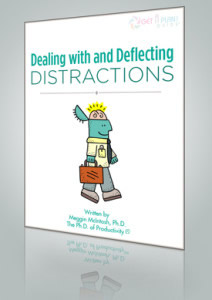Managing Interruptions by Ann Gomez
 By now you know (if you read last week’s) that I advocate focusing (instead of multi-tasking). Focusing on one task at a time is the most productive way to operate – especially when you have a lot of things to do.
By now you know (if you read last week’s) that I advocate focusing (instead of multi-tasking). Focusing on one task at a time is the most productive way to operate – especially when you have a lot of things to do.
But it is hard to focus. There are countless distractions that interrupt our focus emails, phone calls and drop-by visitors. The good news is that there are several things we can do to manage these interruptions. (We often can’t eliminate them, but we can manage them around our focused work sessions.)
Top 10 Ways to Manage Interruptions:
- Turn off the ‘new email’ alerts. That includes the bell, the box that pops up in the corner of your screen and even the flicker of the cursor that seems to speak to our sub-conscious. Instead, commit to checking your email at periodic intervals.
- Close your door. While most offices are trying to instill an ‘open-door philosophy’, there are select times during the day when you would benefit from closing your doors for 30-60 minutes. (Just use this technique selectively to make sure your teachers and other members of your staff respect your need for uninterrupted time.)
- Start your day with a project (instead of email). Generally, we can find some uninterrupted time in the morning. Many writers (including this one) subscribe to this philosophy. Julie Morgenstern also advocates this approach in her book: Never Check E-Mail in The Morning.
- Stand up when someone comes into your office. This is a neat one. This simple technique gives you more control about how long the conversation lasts. If you want to get back to focusing, you can communicate that subtly by sitting down. (Or for your less intuitive visitors, you can take steps to escort them out of your office.)
- Go with a more direct approach and tell your drop-by visitor that you are in the middle of something. Ask them if you can come and see them later in the day. Obviously, use your judgment about the times to use this approach and the times to drop whatever you are doing and attend to their needs or requests.
- Allow your calls to go to voicemail. Just try to get back to people soon after your focus session is done.
- Clear your desk to eliminate visual distractions. I advocate one thing on your desk at a time.
- Share your routine. Let your colleagues know if the best time to chat with you is in the afternoon. Or consider scheduling some regular ‘team’ time each day.
- Consider working off-site. Although it is rare when you can do this, there are times when you could work from home. Swap offices with someone. Book a boardroom. Escape to a coffee shop. If you have 12 evaluations to write and you need to do so in an uninterrupted fashion, then your office at school may not be the best place!
- Accept that some interruptions are warranted. The school environment is a team-based environment after all. We don’t need to be perfect about managing our interruptions. Our goal should simply be to manage some of them so we have more focused work time.
Remember – we don’t need to manage interruptions all day long. We are simply trying to build in an hour of focus time here and 30 minutes of focus time there.
Managing interruptions can be hard to do. But the pay-off is rich. It allows us focus more time and effort on our top priorities. And that seems well worth the effort to me.
© Ann Gomez, BSc, MBA, Productivity Consultant, Clear Concept Inc. Ann Gomez is a corporate trainer, focusing on personal productivity, project management and delegating. She is an avid blogger and is currently working on her book: Work Habits. Sign up for her blog at Clear Concept Inc. Contact Ann at ann.gomez@clearconceptinc.ca.
 If you liked these writing tips, you may be interested in the Get a Plan! Guide® for Dealing with and Deflecting Distractions. It’s specially designed so you can accomplish your goals more smoothly (i.e., peacefully, productively, and predictably). You’ll learn ways to take stock of your distractions, along with 6 means to eliminate – or at the very least, minimize – those distractions. I promise that you will have a plan that you can implement starting today.
If you liked these writing tips, you may be interested in the Get a Plan! Guide® for Dealing with and Deflecting Distractions. It’s specially designed so you can accomplish your goals more smoothly (i.e., peacefully, productively, and predictably). You’ll learn ways to take stock of your distractions, along with 6 means to eliminate – or at the very least, minimize – those distractions. I promise that you will have a plan that you can implement starting today.


